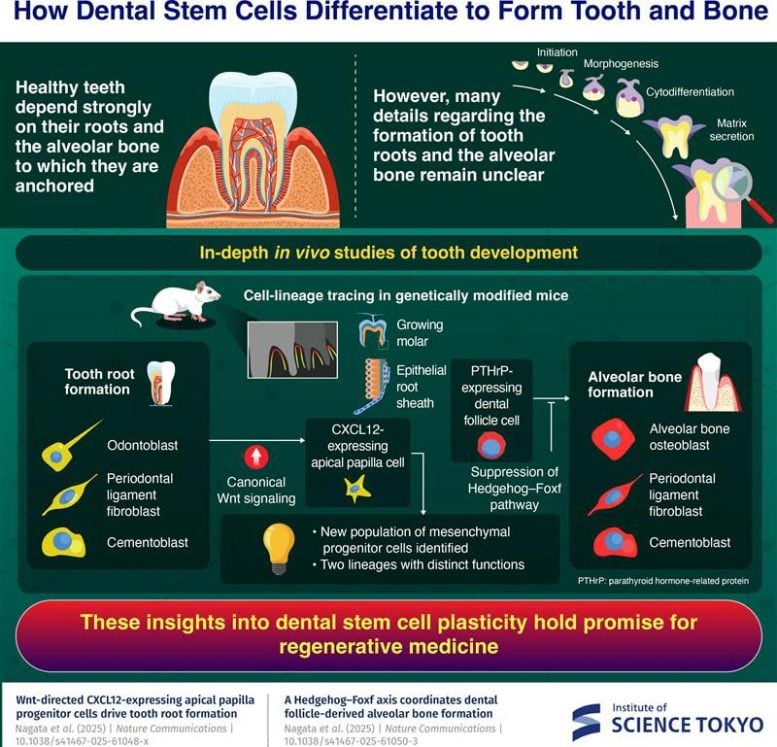Researchers are discovering how cells grow and specialize, paving the way for regenerative dental treatments.
Researchers at Science Tokyo have identified two distinct lineages of stem cells responsible for the formation of tooth roots and the alveolar bone that anchors teeth in the jaw.
Using genetically modified mice and lineage tracing methods, the team discovered how specific signaling pathways direct stem cells toward specialization during tooth development. Their results provide valuable information that could help advance the field of regenerative dentistry in the future.
The challenge of true tooth regeneration
The ability to regrow lost teeth and surrounding bone structures remains one of the most sought-after goals in dental science. For many years, tooth replacement has relied on artificial substitutes such as dental implants and dentures. Although these solutions can effectively restore function and appearance, they cannot fully replicate the natural feel, biological integration, or structural complexity of real teeth.
This limitation has motivated researchers to explore how natural tooth formation occurs, in hopes of developing regenerative treatments that could more completely restore lost teeth.
However, the formation of teeth and bones is an extraordinarily complex process. It depends on the coordinated activity of several tissues, including the enamel organ, dental pulp and jaw cells. These components must communicate via finely tuned signaling networks to control the formation of the dental crown, root, and alveolar bone that supports the tooth. Despite decades of study, many aspects of these interactions remain poorly understood.
Tracing the origins of tooth roots and bone cells
To fill these knowledge gaps, an international team led by Assistant Professor Mizuki Nagata of the Department of Periodontology at the Graduate School of Medical and Dental Sciences, Tokyo Institute of Science (Science Tokyo) and Dr. Wanida Ono of the University of Texas Health Science Center at Houston (UTHealth), collaborated with researchers from the University of Michigan and other institutions.
Their work focused on the molecular and cellular mechanisms that guide stem cell differentiation in tooth development. The results were published in the form of two complementary studies in volume 16 of Natural communications July 1 and 2, 2025.

The team used genetically modified mice and advanced lineage tracing techniques to study how cell populations specialize and organize themselves at the “tip” (apical region) of tooth roots. Using microscopy techniques, fluorescent cell labels and gene silencing, researchers were able to clearly visualize the effects of key signaling proteins on cell fate during tooth development.
Identify two distinct populations of stem cells
In this way, the team identified a previously unknown population of mesenchymal stem cells that give rise to two distinct lineages: one strongly associated with tooth root development and the other with alveolar bone formation. The first lineage arises from cells located in the apical papilla within the epithelial root sheath, a mass of soft tissue at the tip of the growing tooth root.
These cells express CXCL12, a protein that plays a key role in bone formation within the bone marrow. Through a chemical signaling pathway known as the canonical Wnt pathway, cells expressing apical papilla CXCL12 can differentiate not only into tooth-forming odontoblasts, but also into cementum-forming cementoblasts at the elongating tooth root and even into alveolar bone-forming osteoblasts under regenerative conditions.
The other lineage is concentrated in the dental follicle, a sac-like structure that envelops the developing tooth and helps form the surrounding anchorage. The team discovered that a population of cells expressing parathyroid hormone-related protein (PTHrP) can differentiate into bone-forming cementoblasts, ligamentous fibroblasts, and alveolar osteoblasts. Interestingly, the researchers noted that this transformation only occurs under specific circumstances, as Nagata explains: “We observed that the Hedgehog-Foxf pathway must be suppressed to drive the fate of alveolar bone osteoblasts from PTHrP-expressing cells in the dental follicle, thus revealing a unique mechanism of tooth-specific bone formation requiring regulation Hedgehog’s deliberate on-off. signaling. »
Towards regenerative dental therapies
Together, the results of these two studies advance our understanding of tooth and alveolar bone development. in vivoproviding much-needed clues to their complex growth mechanisms. “Our findings provide a mechanistic framework for tooth root formation and pave the way for innovative stem cell-based regenerative therapies for dental pulp, periodontal tissues and bone,” concludes Nagata, looking to the future.
References:
“Wnt-driven CXCL12-expressing apical papilla progenitor cells drive tooth root formation” by Mizuki Nagata, Gaurav T. Gadhvi, Taishi Komori, Yuki Arai, Hiroaki Manabe, Angel Ka Yan Chu, Ramandeep Kaur, Meer Ali, Yuntao Yang, Chiaki Tsutsumi-Arai, Yuta Nakai, Yuki Matsushita, Nicha Tokavanich, W. Jim Zheng, Joshua D. Welch, Noriaki Ono and Wanida Ono, June 31, 2025, Natural communications.
DOI: 10.1038/s41467-025-61048-x
“A Hedgehog-Foxf axis coordinates dental follicle-derived alveolar bone formation” by Mizuki Nagata, Gaurav T. Gadhvi, Taishi Komori, Yuki Arai, Chiaki Tsutsumi-Arai, Angel Ka Yan Chu, Seth N. Nye, Yuntao Yang, Shion Orikasa, Akira Takahashi, Peter Carlsson, W. Jim Zheng, Joshua D. Welch, Noriaki Ono and Wanida Ono, July 2, 2025, Natural communications.
DOI: 10.1038/s41467-025-61050-3
Funding: National Institutes of HealthCancer Prevention and Research Institute of Texas, Japanese Society of Periodontology, Japan Society for the Promotion of Science
Never miss a major breakthrough: join the SciTechDaily newsletter.
Follow us on Google, Discover and News.









